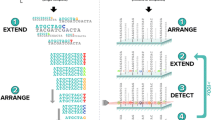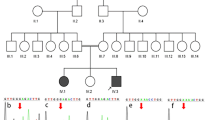Abstract
Background
Neurological disorders are clinically heterogeneous group of disorders and are major causes of disability and death. Several of these disorders are caused due to genetic aberration. A precise and confirmatory diagnosis in the patients in a timely manner is essential for appropriate therapeutic and management strategies. Due to the complexity of the clinical presentations across various neurological disorders, arriving at an accurate diagnosis remains a challenge.
Methods
We sequenced 1012 unrelated patients from India with suspected neurological disorders, using TruSight One panel. Genetic variations were identified using the Strand NGS software and interpreted using the StrandOmics platform.
Results
We were able to detect mutations in 197 genes in 405 (40%) cases and 178 mutations were novel. The highest diagnostic rate was observed among patients with muscular dystrophy (64%) followed by leukodystrophy and ataxia (43%, each). In our cohort, 26% of the patients who received definitive diagnosis were primarily referred with complex neurological phenotypes with no suggestive diagnosis. In terms of mutations types, 62.8% were truncating and in addition, 13.4% were structural variants, which are also likely to cause loss of function.
Conclusion
In our study, we observed an improved performance of multi-gene panel testing, with an overall diagnostic yield of 40%. Furthermore, we show that NGS (next-generation sequencing)-based testing is comprehensive and can detect all types of variants including structural variants. It can be considered as a single-platform genetic test for neurological disorders that can provide a swift and definitive diagnosis in a cost-effective manner.


Similar content being viewed by others
References
Gourie-Devi M (2014) Epidemiology of neurological disorders in India: review of background, prevalence and incidence of epilepsy, stroke, Parkinson′s disease and tremors. Neurol India 62:588. https://doi.org/10.4103/0028-3886.149365
Deenen JCW, Horlings CGC, Verschuuren JJGM et al (2015) The epidemiology of neuromuscular disorders: a comprehensive overview of the literature. J Neuromuscul Dis 2:73–85. https://doi.org/10.3233/JND-140045
Biskup S, Gasser T (2012) Genetic testing in neurological diseases. J Neurol 259:1249–1254. https://doi.org/10.1007/s00415-012-6511-9
Vissers LELM, Van Nimwegen KJM, Schieving JH et al (2017) A clinical utility study of exome sequencing versus conventional genetic testing in pediatric neurology. Genet Med 19:1055–1063. https://doi.org/10.1038/gim.2017.1
Muzzey D, Evans EA, Lieber C (2015) Understanding the basics of NGS: from mechanism to variant calling. Curr Genet Med Rep 3:158–165. https://doi.org/10.1007/s40142-015-0076-8
Xue Y, Ankala A, Wilcox WR, Hegde MR (2015) Solving the molecular diagnostic testing conundrum for Mendelian disorders in the era of next-generation sequencing: single-gene, gene panel, or exome/genome sequencing. Genet Med 17:444–451. https://doi.org/10.1038/gim.2014.122
Strom SP, Lee H, Das K et al (2014) Assessing the necessity of confirmatory testing for exome-sequencing results in a clinical molecular diagnostic laboratory. Genet Med 16:510–515. https://doi.org/10.1038/gim.2013.183
Katsanis SH, Katsanis N (2016) Molecular genetic testing and the future of clinical genomics. Genomic Precis Med Found Transl Implement Third Ed 14:263–282. https://doi.org/10.1016/B978-0-12-800681-8.00018-9
Bhattacharya S, Khadilkar SV, Nalini A et al (2018) Mutation spectrum of GNE myopathy in the Indian sub-continent. J Neuromuscul Dis 5:85–92. https://doi.org/10.3233/JND-170270
Kapoor S, Shah MH, Singh N et al (2016) Genetic analysis of PLA2G6 in 22 Indian families with infantile neuroaxonal dystrophy, atypical late-onset neuroaxonal dystrophy and dystonia parkinsonism complex. PLoS ONE 11:1–12. https://doi.org/10.1371/journal.pone.0155605
Bidchol AM, Dalal A, Trivedi R et al (2015) Recurrent and novel GLB1 mutations in India. Gene 567:173–181. https://doi.org/10.1016/j.gene.2015.04.078
Deepha S, Vengalil S, Preethish-Kumar V et al (2017) MLPA identification of dystrophin mutations and in silico evaluation of the predicted protein in dystrophinopathy cases from India. BMC Med Genet 18:1. https://doi.org/10.1186/s12881-017-0431-6
Giri S, Naiya T, Equbal Z et al (2017) Genetic screening of THAP1 in primary dystonia patients of India. Neurosci Lett 637:31–37. https://doi.org/10.1016/j.neulet.2016.11.060
Raju PK, Satishchandra P, Nayak S et al (2017) Microtubule-associated defects caused by EFHC1 mutations in juvenile myoclonic epilepsy. Hum Mutat 38:816–826. https://doi.org/10.1002/humu.23221
Mannan AU, Singh J, Lakshmikeshava R et al (2016) Detection of high frequency of mutations in a breast and/or ovarian cancer cohort: implications of embracing a multi-gene panel in molecular diagnosis in India. J Hum Genet 61:515–522. https://doi.org/10.1038/jhg.2016.4
Richards S, Aziz N, Bale S et al (2015) Standards and guidelines for the interpretation of sequence variants: a joint consensus recommendation of the American College of Medical Genetics and Genomics and the Association for Molecular Pathology. Genet Med 17:405–424. https://doi.org/10.1038/gim.2015.30
Singh J, Mishra A, Pandian AJ et al (2016) Next-generation sequencing-based method shows increased mutation detection sensitivity in an Indian retinoblastoma cohort. Mol Vis 22:1036–1047
Singh J, Thota N, Singh S et al (2018) Screening of over 1000 Indian patients with breast and/or ovarian cancer with a multi-gene panel: prevalence of BRCA1/2 and non-BRCA mutations. Breast Cancer Res Treat 170:189–196. https://doi.org/10.1007/s10549-018-4726-x
Mu W, Lu HM, Chen J et al (2016) Sanger confirmation is required to achieve optimal sensitivity and specificity in next-generation sequencing panel testing. J Mol Diagnostics 18:923–932. https://doi.org/10.1016/j.jmoldx.2016.07.006
Baudhuin LM, Lagerstedt SA, Klee EW et al (2015) Confirming variants in next-generation sequencing panel testing by sanger sequencing. J Mol Diagnostics 17:456–461. https://doi.org/10.1016/j.jmoldx.2015.03.004
Farwell KD, Shahmirzadi L, El-Khechen D et al (2015) Enhanced utility of family-centered diagnostic exome sequencing with inheritance model-based analysis: results from 500 unselected families with undiagnosed genetic conditions. Genet Med 17:578–586. https://doi.org/10.1038/gim.2014.154
Lee H, Deignan JL, Dorrani N et al (2014) Clinical exome sequencing for genetic identification of rare mendelian disorders. JAMA J Am Med Assoc 312:1880–1887. https://doi.org/10.1001/jama.2014.14604
Retterer K, Juusola J, Cho MT et al (2016) Clinical application of whole-exome sequencing across clinical indications. Genet Med 18:696–704. https://doi.org/10.1038/gim.2015.148
Trujillano D, Bertoli-Avella AM, Kumar Kandaswamy K et al (2017) Clinical exome sequencing: results from 2819 samples reflecting 1000 families. Eur J Hum Genet 25:176–182. https://doi.org/10.1038/ejhg.2016.146
Yang Y, Muzny DM, Xia F et al (2015) NIH Public Access. JAMA 312:1870–1879. https://doi.org/10.1001/jama.2014.14601.Molecular
Lindy AS, Stosser MB, Butler E et al (2018) Diagnostic outcomes for genetic testing of 70 genes in 8565 patients with epilepsy and neurodevelopmental disorders. Epilepsia 59:1062–1071. https://doi.org/10.1111/epi.14074
Carvill GL, Heavin SB, Yendle SC et al (2013) HHS Public Access. Nat Genet 45:825–830. https://doi.org/10.1038/ng.2646.Targeted
Trump N, McTague A, Brittain H et al (2016) Improving diagnosis and broadening the phenotypes in early-onset seizure and severe developmental delay disorders through gene panel analysis. J Med Genet 53:310–317. https://doi.org/10.1136/jmedgenet-2015-103263
Kang C, Liang C, Ahmad KE et al (2019) High degree of genetic heterogeneity for hereditary cerebellar ataxias in Australia. Cerebellum 18:137–146. https://doi.org/10.1007/s12311-018-0969-7
Hadjivassiliou M, Martindale J, Shanmugarajah P et al (2017) Causes of progressive cerebellar ataxia: prospective evaluation of 1500 patients. J Neurol Neurosurg Psychiatry 88:301–309. https://doi.org/10.1136/jnnp-2016-314863
Savarese M, Di Fruscio G, Magri F et al (2016) The genetic basis of undiagnosed muscular dystrophies and myopathies: results from 504 patients. Neurology. https://doi.org/10.1212/WNL.0000000000002800
Miller DT, Adam MP, Aradhya S et al (2010) Consensus statement: chromosomal microarray is a first-tier clinical diagnostic test for individuals with developmental disabilities or congenital anomalies. Am J Hum Genet 86:749–764. https://doi.org/10.1016/j.ajhg.2010.04.006
Truty R, Paul J, Kennemer M et al (2018) Prevalence and properties of intragenic copy-number variation in Mendelian disease genes. Genet Med. https://doi.org/10.1038/s41436-018-0033-5
Okubo M, Minami N, Goto K et al (2016) Genetic diagnosis of Duchenne/Becker muscular dystrophy using next-generation sequencing: validation analysis of DMD mutations. J Hum Genet 61:483–489. https://doi.org/10.1038/jhg.2016.7
Bowling KM, Thompson ML, Amaral MD et al (2017) Genomic diagnosis for children with intellectual disability and/or developmental delay. Genome Med 9:1–11. https://doi.org/10.1186/s13073-017-0433-1
Hamdan FF, Myers CT, Cossette P et al (2017) High rate of recurrent de novo mutations in developmental and epileptic encephalopathies. Am J Hum Genet 101:664–685. https://doi.org/10.1016/j.ajhg.2017.09.008
Stavropoulos DJ, Merico D, Jobling R et al (2016) Whole-genome sequencing expands diagnostic utility and improves clinical management in paediatric medicine. NPJ Genomic Med. https://doi.org/10.1038/npjgenmed.2015.12
Acknowledgements
We thank the patients and families, who consented to participate in this study. We thank all the physicians, who referred the patients to our centre. We also thank the Strand Life Sciences laboratory, bioinformatics, interpretation and genetic counselling staff for providing the infrastructure needed for this study.
Funding
For this study, funding was not obtained from any funding body; therefore, there is no role of any funding body in the design of the study and collection, analysis, and interpretation of data and in writing the manuscript.
Author information
Authors and Affiliations
Contributions
AG—acquisition of data, analysis of data, interpretation and critical review of data, drafting of manuscript. AV, MRS—acquisition of data, analysis of data, interpretation of data, making of figures. PK, MS, AVK, IRPP, SG, AS, TTC, ASL, VHK, SMC—acquisition of data, interpretation of data. VR, SN, RM, DP, VU, NN, MK, ARRD, MK, SJ, MN, AUH, MPP, SS, PT, RP, AH, KS, JS—acquisition of data and concept of the study. PA—acquisition of data, sequencing. SK, VV—analysis and validation. AM, AG—conception and design of study, analysis of data, interpretation and critical review of data, drafting of manuscript. AM, VC, RH—critical inputs and finalization of the manuscript. All authors contributed in preparation of the manuscript, read and approved the final manuscript.
Corresponding author
Ethics declarations
Conflicts of interest
AG, AV, MRS, PK, MS, AVK, IRPP, SG, AS, TTC, ASL, VHK, SMC, SN, MBP, VGR, MP, PA, SK, VV, VC, RH, AM are employees of Strand Life Sciences that offer commercially available clinical genetic testing services.
Ethical standards
Sequencing of patient samples used in the study has been approved by Institutional Ethics Committee of Strand Life Sciences.
Informed consent
Informed consent was obtained in writing from all subjects and sequencing of patient samples was approved by Institutional Ethics Committee of Strand Life Sciences.
Electronic supplementary material
Below is the link to the electronic supplementary material.
Rights and permissions
About this article
Cite this article
Ganapathy, A., Mishra, A., Soni, M.R. et al. Multi-gene testing in neurological disorders showed an improved diagnostic yield: data from over 1000 Indian patients. J Neurol 266, 1919–1926 (2019). https://doi.org/10.1007/s00415-019-09358-1
Received:
Revised:
Accepted:
Published:
Issue Date:
DOI: https://doi.org/10.1007/s00415-019-09358-1




